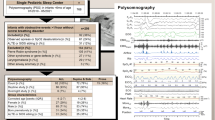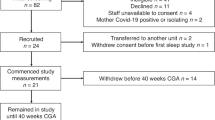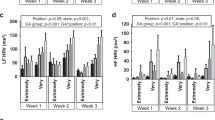Abstract
Supine sleeping, recommended to prevent sudden infant death, should be started in the delivery hospital, but meets concern that neonates may exhibit more intermittent hypoxia in this position. We aimed to demonstrate that intermittent hypoxia is equally rare in supine and side position. We enrolled 609 term neonates in a crossover study. Pulse oximeter saturation (Spo2) was recorded throughout; feeding periods were excluded. The rate of desaturation events to <80%/h was the primary study variable. Four hundred seventy-six recordings fulfilled study criteria. Mean duration of recording was 4.8 h in side and 4.9 h in supine position (SD 0.8 for both). There was a mean of 0.11 desaturation events per hour in supine and 0.05 per hour in side position. Of the 118 infants with desaturation events, more had such events only in supine position (64 vs. 31 infants). For supine compared with side position, the adjusted odds ratio for at least one desaturation event was 2.0 (95% confidence interval 1.3–3.1). The lowest Spo2 value reached during these events was 56% in supine and 53% in side position. These neonates had more desaturation events while sleeping supine. We speculate, however, that this positional effect likely is too small to affect outcome.
Similar content being viewed by others
Main
Supine sleeping is recommended to prevent the sudden infant death syndrome (SIDS). It should already be started in the delivery hospital, because the policy applied there models parental behavior later on (1). Published data and anecdotal evidence suggest, however, that mothers and nurses often prefer the side position for fear of choking and “turning blue” (1), preventing propagation of the “reduce-the-risk” message. To address this concern, we compared neonatal pulse oximeter saturation (Spo2) in supine vs. side sleeping position, hypothesizing that there is no clinically relevant difference in the occurrence of desaturation events.
METHODS
We performed a randomized crossover study in term neonates aged 0–5 d, born at Tuebingen University Hospital and admitted to the maternity or neonatal unit (the latter for common neonatal problems such as mild jaundice, hypoglycemia, or hypothermia) between October 2002 and September 2005. All were considered clinically well at enrollment. Written informed parental consent was given in each patient.
Infants were placed in a cotton sleeping bag with long sleeves (Odenwälder, Limbach, Germany) in horizontal supine and side position in random sequence for 6 h each; no pillows were used. Otherwise, they received their routine care. Caregivers were advised to record all feeding periods to exclude them from analysis.
Spo2 and a signal quality indicator (Signal IQ) were recorded with a motion-resistant oximeter at a sampling rate of 1 Hertz [VitaGuard 310; GeTeMed, Teltow, Germany with Masimo SET, Irvine, CA; 2–4 s averaging mode (2)]. Alarms were only active for severe hypoxemia (Spo2 <70%) and extreme bradycardia/tachycardia (pulse rate <60/>260/min) as it was not clinical routine to monitor infants on the neonatal or maternity unit. Having discarded periods with feeding or poor signal, recordings yielding ≥3 h in each position were included. Recording periods were defined as artifact free when signal IQ was >0.3 (2). Events were manually confirmed based on appropriate signal quality. A desaturation event was defined as a fall in Spo2 to <80%, with the oximeter updating its memory every second, yielding a minimum event duration of 1 s. This minimum duration and threshold level were chosen to comply with previous work, which showed that these criteria are ideally suited to trace maturational and disease-related changes in respiratory control during infancy (3,4). Two different definitions for desaturation events were used: definition A: Spo2 <80% and good signal quality (2); definition B: Spo2 <80%, good signal quality and undisturbed pulse wave form (5). For 30 s around each desaturation event, recordings were also analyzed for the presence of bradycardia, defined as a fall in pulse rate to <80/min.
The occurrence of desaturation events was the primary study variable. On the basis of event rates in a previous study (5), we estimated that paired measurements in 485 infants would give a power of >90% with a one-sided type I-error <0.05 to detect a 33% difference in event rates between the two positions. Data were extremely right skewed; we thus dichotomized the event rate (no vs. at least one event) and used unconditional logistic regression analysis and a random effects model. Odds ratios (OR) and their 95% confidence intervals (95% CI) were calculated for supine position using side position as reference. ORs were adjusted for study phase, study location, and the logarithm of the recording time. As a sensitivity analysis, both variants of desaturation event definition were used. Statistical analyses were done using Stata 9.2 (Stata Corp., College Station, TX). A p value <0.05 was considered statistically significant. The study protocol had been approved by the Ethics committee of Tübingen University Hospital.
RESULTS
Of 609 infants studied, 476 pairs of recordings were of sufficient duration (Table 1 for demographic data). There was a mean of 0.11 desaturation events per hour in supine and 0.05 per hour in side position. Of the 118 infants with desaturation events, more had such events only in supine position (64 vs. 31 infants). The mean duration of these events did not differ between positions (Table 2). The longest desaturation event found lasted 141 s in supine and 101 s in side position. The lowest Spo2 value reached during desaturation events was 56% in supine and 53% in side position. The odds of having a desaturation event were significantly higher in supine position. This was independent of the event definition used [adjusted OR (95%CI; p value) for definition A: 2.0 (1.3–3.1; 0.001); for definition B: 2.4 (1.4–4.1; 0.001)]. This effect of sleep position was independent of study location and study phase (Table 2). Three infants had desaturation events to <60% Spo2 in supine position (Fig. 1), compared with only one in side position. All four events occurred within 45 min after a feed. Only one infant had a desaturation event accompanied by bradycardia (in supine position). All events were self-resolving; no infant was stimulated or received additional inspired oxygen.
Example of a desaturation event occurring at 03:39 AM in a 2-d old healthy boy in supine position, 24 min after his last feed. Spo2 is <80% for 1 min, reaching a minimum of 59%. Nurses did not note any clinical abnormality at the time of this event. The infant had finished his last feed at 03:15 AM. The hatched area indicates the time the recording threshold was violated; the gray area indicates the time the monitor alarm had sounded until it was silenced.
DISCUSSION
While sleeping supine, these term neonates were more likely to have desaturation events than in the side position, refuting our study hypothesis, but matching the caregivers' observation prompting this study. This could have been caused by more obstructive apnea in the supine position, potentially caused by gravity allowing the tongue to fall backward (6), or by gastroesophageal reflux, which is more prevalent in supine position (7). Suggestive of the latter potential explanation is the proximity of the most severe events (to <60% Spo2) to feeding episodes. Our study had not been designed to investigate causal factors for this position-dependent increase in intermittent hypoxia, but given the number of infants enrolled and the fact that this positional effect was found in both, the maternity ward and the neonatal unit (with its potentially better documentation by nursing staff), underscores that this effect is real and not just a spurious finding.
Mothers and nurses were instructed about infant placement and how to keep the feeding protocols, but we did not confirm this objectively, nor did we record further physiologic data such as breathing movements or ECG. Infants sleep less in the supine position (8), potentially allowing more time for motion, during which episodic desaturation may be more likely. This is unlikely to explain our results, however, as episodes with poor signal quality (as frequently present during motion) were excluded, and position-related differences persisted regardless which criteria were used to exclude potentially spurious Spo2 values. Only 476 of 609 recordings fulfilled study criteria, nine short of our planned sample size. Sample size, however, is less relevant here because we did observe a significant difference between positions. We focused on desaturations to <80 or <60% Spo2. This happened because desaturations by 4% or to <90%, frequently used as a cutoff in older children, are so common in neonates that they can be regarded as normal physiology and were not considered by us to be clinically meaningful.
There is one other study that compared acute decreases in Spo2 in side vs. supine position, analyzing home monitor recordings in 64 healthy infants between 2 and 25 wk of age (9). These authors found a frequency of decreases in Spo2 by at least 10% (and sustained <90% for ≥5 s, using a pulse oximeter in the beat-to-beat mode) of 0.4 s/h in side vs. 1.8 s/h in supine position. The rate of these events decreased with increasing age; most (79%) were related to periodic breathing. Periodic breathing, however, was equally common in supine and side position in that study. Although not directly comparable with our data, these results suggest that the increased propensity to intermittent hypoxia in the supine position continues beyond the neonatal period, but that intermittent hypoxia will become rarer as the infant grows older.
Intermittent hypoxia during sleep may affect neurocognition in children (10), but whether this is also true for neonates and for the extent of desaturation seen here is questionable. In fact, it is more likely that these intermittent, self-resolving desaturation events reflect a physiologic phenomenon, which happens to be influenced by body position, but is of no long-term consequence. An argument in support of the latter hypothesis is our observation that only one of the 368 desaturation events was accompanied by bradycardia. In addition, infants born preterm exhibit much more frequent and severe episodes of intermittent hypoxia, even once they are beyond term equivalent age (11), but these do not seem to have much effect on neurodevelopment (12,13).
Undoubtedly, the side position is associated with an increased risk of SIDS, and parental choice of sleep position is positively related to that chosen by nursing staff (14). Thus, we are faced with a dilemma: on one hand, there may be more intermittent hypoxia in the supine position (at least in the neonatal period), the long-term effect of which is unknown, but likely negligible in this age group. On the other hand, there is a known risk of death associated with nonsupine sleeping. Thus, for the time being, it would seem unethical to recommend anything other than supine sleeping in the first year of life. Once more data become available, however, a more sophisticated recommendation is conceivable. Preterm infants, for example, are placed prone as long as they exhibit apnea of prematurity, but are turned to supine once they have outgrown this (15,16). In a similar line of argument, side sleeping may be a preferable sleep position just for the first week of life (before SIDS becomes an issue), followed by supine sleeping for older infants. More data, however, are needed before considering giving such a recommendation, and even then the risk of diluting the simple back-to-sleep message by such sophisticated advice needs to be considered, as it may be difficult to get it across to the public. Thus, we continue to recommend supine sleeping already in the delivery hospital, but urge for further research into the long-term effects, and the natural course, of intermittent hypoxia early in life.
Abbreviations
- Spo2:
-
pulse oximeter saturation
References
Colson ER, Levenson S, Rybin D, Calianos C, Margolis A, Colton T, Lister G, Corwin MJ 2006 Barriers to following the supine sleep recommendation among mothers at four centers for the Women, Infants, and Children Program. Pediatrics 118: e243–e247
Urschitz MS, von Einem V, Seyfang A, Poets CF 2002 Use of pulse oximetry in automated O2 delivery to ventilated infants. Anesth Analg 94: S37–S40
Poets CF, Stebbens VA, Southall DP 1991 Arterial oxygen saturation and breathing movements during the first year of life. J Dev Physiol 15: 341–345
Poets CF, Stebbens VA, Arrowsmith WA, Salfield SA, Southall DP 1992 Hypoxaemia in infants with respiratory tract infections. Acta Paediatr 81: 536–541
O'Brien LM, Stebbens VA, Poets CF, Heycock EG, Southall DP 2000 Oxygen saturation during the first 24 hours of life. Arch Dis Child Fetal Neonatal Ed 83: F35–F38
Cartwright RD 1984 Effect of sleep position on sleep apnea severity. Sleep 7: 110–114
Tobin JM, McCloud P, Cameron DJ 1997 Posture and gastro-oesophageal reflux: a case for left lateral positioning. Arch Dis Child 76: 254–258
Kahn A, Groswasser J, Sottiaux M, Rebuffat E, Franco P, Dramaix M 1993 Prone or supine body position and sleep characteristics in infants. Pediatrics 91: 1112–1115
Hunt CE, Corwin MJ, Lister G, Weese-Mayer DE, Neuman MR, Tinsley L, Baird TM, Keens TG, Cabral HJ 1999 Longitudinal assessment of hemoglobin oxygen saturation in healthy infants during the first 6 months of age. J Pediatr 135: 580–586
Bass JL, Corwin M, Gozal D, Moore C, Nishida H, Parker S, Schonwald Wilker RE, Stehle S, Kinane TB 2004 The effect of chronic or intermittent hypoxia on cognition in childhood: a review of the evidence. Pediatrics 114: 805–816
Poets CF, Stebbens VA, Alexander JR, Arrowsmith WA, Salfield SA, Southall DP 1992 Arterial oxygen saturation in preterm infants at discharge from the hospital and 6 weeks later. J Pediatr 120: 447–454
Koons AH, Mojica N, Jadeja N, Ostfeld B, Hiatt M, Hegyi T 1993 Neurodevelopmental outcome of infants with apnea of infancy. Am J Perinatol 10: 208–211
Cheung PY, Barrington KJ, Finer NN, Robertson CM 1999 Early childhood neurodevelopment in very low birth weight infants with predischarge apnea. Pediatr Pulmonol 27: 14–20
Bullock LF, Mickey K, Green J, Heine A 2004 Are nurses acting as role models for the prevention of SIDS?. MCN Am J Matern Child Nurs 29: 172–177
Poets CF, von Bodman A 2007 Sleeping position in prematurely born infants: first prone, then supine. Arch Dis Child Fetal Neonatal Ed 92: F331–F332
Aris C, Stevens TP, Lemura C, Lipke B, McMullen S, Cote-Arsenault D, Consenstein L 2006 NICU nurses' knowledge and discharge teaching related to infant sleep position and risk of SIDS. Adv Neonatal Care 6: 281–294
Acknowledgements
We thank Martin Schlaud for performing the power calculation, Lena Fröhling, M.D., Gisela Trapp, M.D., Florian Nowotny, and Viviane Ishak-Lesnik for their help with performing these recordings, Christiane Sokollik for her help with data analysis, David Martin for linguistic advice and GeTeMed (Teltow, Germany) and Masimo Inc. (Irvine, CA) for providing the monitors and sensors used in this study.
Author information
Authors and Affiliations
Rights and permissions
About this article
Cite this article
Poets, A., Urschitz, M. & Poets, C. Intermittent Hypoxia in Supine Versus Side Position in Term Neonates. Pediatr Res 65, 654–656 (2009). https://doi.org/10.1203/PDR.0b013e31819e76b1
Received:
Accepted:
Issue Date:
DOI: https://doi.org/10.1203/PDR.0b013e31819e76b1
This article is cited by
-
Optimale Entlassung sehr unreifer Frühgeborener
Monatsschrift Kinderheilkunde (2019)
-
Combined effects of body position and sleep status on the cardiorespiratory stability of near-term infants
Scientific Reports (2018)




